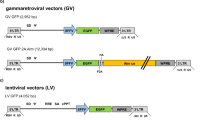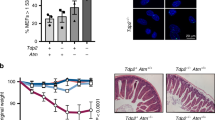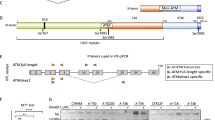Abstract
ATAXIA telangiectasia (AT) (Louis–Bar syndrome) is a rare human neurovascular disease displaying an autosomal recessive pattern of inheritance1–3. Affected individuals, although clinically normal at birth, symptomatically develop cerebellar ataxia (loss of muscular coordination) and oculocutaneous telangiectasis (chronic dilation of the small blood vessels) in early childhood. The course of the disease follows a variable progression commonly leading to total neurological incapacitation before puberty. Accessory complications include lymphoreticular neoplasia2,3, bronchiectasis1,2, recurrent sinopulmonary infections1,2, decreased levels of serum immunoglobulins IgA and IgE (refs 3 and 4), impaired cellular immunity3,4, and widespread chromosomal instability5. AT patients, on receiving conventional radiotherapy for tumour treatment, tend to develop unusually severe complications often culminating in premature death6–8. Pronounced radiosenitivity is also observed at the cellular level in laboratory studies; the number of radiation-induced chromosomal aberrations is enhanced in leukocytes obtained from AT donors9. Moreover, diploid fibroblasts cultured from affected individuals exhibit a reduced ability to form colonies following exposure to γ radiation10 and radiomimetic chemicals11. Since the principal damage induced by both types of agents occurs in the DNA and seems to be acted on by the same enzymatic repair mechanisms12,13, it would seem probable that the molecular basis for the clinical radiosensitivity of AT patients stems from a deficient DNA repair mechanism. We therefore measured the DNA repair properties of AT fibroblasts after exposure to γ radiation. Data presented below provide direct biochemical evidence that diploid strains from AT donors are indeed impaired in DNA repair; in particular, these cell lines possess an enzymatic defect in an excision-type repair process operating on γ-modified nitrogenous base residues.
This is a preview of subscription content, access via your institution
Access options
Subscribe to this journal
Receive 51 print issues and online access
$199.00 per year
only $3.90 per issue
Buy this article
- Purchase on Springer Link
- Instant access to full article PDF
Prices may be subject to local taxes which are calculated during checkout
Similar content being viewed by others
References
Boder, E., and Sedgwick, R. P., Little Club clin. dev. Med., 8, 110–118 (1963).
Peterson, R. D., Kelly, W. D., and Good, R. A., Lancet, 1, 1189–1193 (1964).
Peterson, R. D. A., Cooper, M. D., and Good, R. A., Am. J. Med., 41, 342–359 (1966).
Strober, W., Wochner, R. D., Barlow, M. H., McFarlin, D. E., and Waldmann, T. A., J. clin. Invest., 47, 1905–1915 (1968).
Harnden, D. G., Chromosomes and Cancer (edit. by German, J.), 619–636 (Wiley, New York, 1974).
Gotoff, S. P., Amirmokri, E., and Liebner, E. J., Am. J. Dis. Childh., 114, 617–625 (1967).
Morgan, J. L., Holcomb, T. M., and Morrissey, R. W., Am. J. Dis. Childh., 116, 557–558 (1968).
Cunliffe, P. N., Mann, J. R., Cameron, A. H., Roberts, K. D., and Ward, H. W. C., Br. J. Radial, 48, 374–376 (1975).
Higurashi, M., and Conen, P. E., Cancer, 32, 380–383 (1973).
Taylor, A. M. R., et al., Nature, 258, 427–429 (1975).
Hoar, D. I., and Sargent, P., Am. J. hum. Genet. (in the press).
Regan, J. D., and Setlow, R. B., Cancer Res., 34, 3318–3325 (1974).
Cerutti, P. A., Life Sci., 15, 1567–1575 (1974).
Paterson, M. C., Lohman, P. H. M., and Sluyter, M. L., Mutat. Res., 19, 245–256 (1973).
Paterson, M. C., Adv. Radiat. Biol., 7, (in the press).
Lohman, P. H. M., Sluyter, M. L., Matthijs, I. A. A., and Kleijer, W. J., Analyt. Biochem., 54, 178–187 (1973).
Paterson, M. C., and Setlow, R. B., Proc. natn. Acad. Sci. U.S.A., 69, 2927–2931 (1972).
Cleaver, J. E., Adv. Radiat. Biol., 4, 1–75 (1974).
Ham, R. G., Proc. natn. Acad. Sci. U.S.A., 53, 288–293 (1965).
Vincent Jr., R. A., Sheridan III, R. B., and Huang, P. C., Mutat. Res., 33, 357–366 (1975).
Schneider, E. L., Stanbridge, E. J., and Epstein, C. J., Expl Cell Res., 84, 311–318 (1974).
Strniste, G. F., and Wallace, S. S., Proc. natn. Acad. Sci U.S.A., 72, 1997–2001 (1975).
Noguti, T., and Kada, T., Biochim. biophys. Acta, 395, 294–305 (1975).
Cleaver, J. E., Nature, 218, 652–656 (1968).
Carrier, W. L., and Setlow, R. B., J. Bact., 102, 178–186 (1970).
Author information
Authors and Affiliations
Rights and permissions
About this article
Cite this article
PATERSON, M., SMITH, B., LOHMAN, P. et al. Defective excision repair of γ-ray-damaged DNA in human (ataxia telangiectasia) fibroblasts. Nature 260, 444–447 (1976). https://doi.org/10.1038/260444a0
Received:
Accepted:
Issue Date:
DOI: https://doi.org/10.1038/260444a0
This article is cited by
-
Radiological Imaging in Ataxia Telangiectasia: a Review
The Cerebellum (2014)
-
Repair of gamma ray-induced S1 nuclease hypersensitive sites in yeast depends on homologous mitotic recombination and a RAD18-dependent function
Current Genetics (1991)
-
Induction, repair and biological relevance of radiation-induced DNA lesions in eukaryotic cells
Radiation and Environmental Biophysics (1990)
-
Cytogenetic investigations in a family with ataxia telangiectasia
Human Genetics (1989)
Comments
By submitting a comment you agree to abide by our Terms and Community Guidelines. If you find something abusive or that does not comply with our terms or guidelines please flag it as inappropriate.



